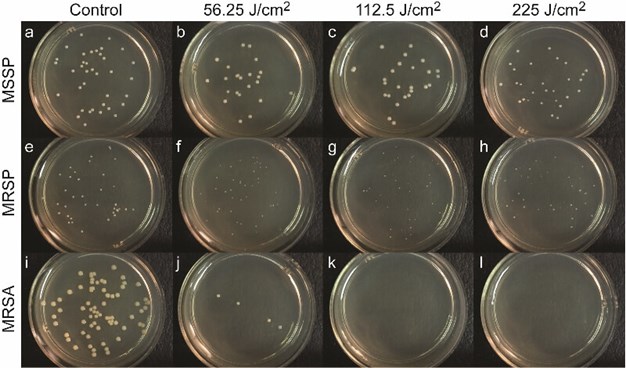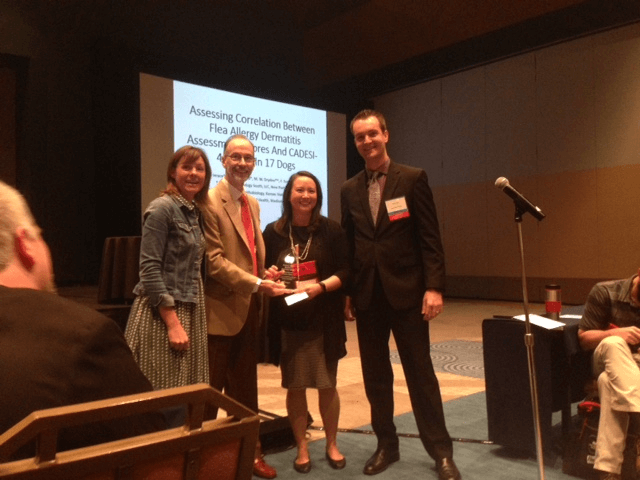Veterinarian completes blue light study using Multi Radiance Medical ACTIVet PRO super pulsed laser
Wednesday October 4, 2017
The Ohio State University veterinary dermatology residency graduate Amy Schnedeker, DVM, MS, recently completed a study on the effects of blue light on common bacteria using Multi Radiance Medical’s MR4 ACTIVet PRO super pulsed laser.
Blue light has been used to treat common skin infections due to its antimicrobial properties, which are similar to those of ultraviolet (UV) radiation, but without the risks of UV exposure. As bacteria become more resistant to antibiotics and drug side effects get worse, interest in the safe and drug-free modality continues to grow.
“In veterinary medicine, unfortunately we deal with a lot of resistant infections, so we can’t really rely on antibiotics anymore,” Schnedeker said, “and even the antibiotics we do have left can make dogs really sick.”
When she started her residency in 2014, Schnedeker’s faculty mentor Lynette Cole, DVM, MS Diplomate ACVD, and Professor of Dermatology, introduced her to the MR4 ACTIVet, the ACTIVet PRO’s predecessor, which had been recently donated to the school. She was inspired to design a clinical trial when a technician’s dog was using the laser for a lick granuloma, a difficult-to-treat skin lesion aggravated by constant licking from the affected dog.
“We wanted to find a new way to treat this really difficult and frustrating disease, because the research is lacking,” Schnedeker said.
Due to time constraints with recruiting enough dogs for a statistically accurate study, Schnedeker had to forgo the trial for her residency research, but she was still interested in exploring the effects of blue light. After contacting Multi Radiance Medical’s Doug Johnson, Senior VP of Clinical and Educational Affairs, she received the ACTIVet PRO, which has more power and stronger blue light than the original.
Schnedeker’s study aimed to replicate past research from Dr. Violet Bumah, whose in vitro study found that blue light almost completely eradicated colonies of meticillin-resistant Staphylococcus aureus (MRSA), a bacterium that causes antibiotic-resistant skin infections in humans.
Schnedeker used three doses on her MRSA colonies: low at 56.25 J/cm²; medium at 112.5 J/cm²; and high at 225 J/cm². She shone blue light over petri dishes of the bacteria colonies and then manually counted the colonies after. At the lowest dose, the blue light killed 93% of the MRSA colonies, and 100% of the bacteria were killed at both the medium and high doses.
After successfully replicating the results from Bumah’s study, Schnedeker used the same parameters to test blue light on meticillin-resistant Staphylococcus pseudintermedius (MRSP) and meticillin-susceptible Staphylococcus pseudintermedius (MSSP), which affect animals.
The results, however, showed that the blue light did not reduce the MRSP and MSSP bacteria as effectively as the MRSA; at the highest dose, only 21.2% of the MRSP and 11.7% of the MSSP were killed.

Supporting Information Figure S11: Representative culture plates of MSSP (a-d), MRSP (KM1381) (e-h) and MRSA (BAA-1680) (i-l) irradiated with 56.25, 112.5 and 225 J/cm2 465 nm blue light. Control plates (a,e,i) were not irradiated. MSSP meticillin-susceptible Staphylococcus pseudintermedius; MRSP meticillin-resistant Staphylococcus pseudintermedius; MRSA meticillin-resistant Staphylococcus aureus

Supporting Information Table S11: Combined median, interquartile range and range of colony counts for control groups and treatment groups (meticillin-susceptible Staphylococcus pseudintermedius, meticillin-resistant Staphylococcus pseudintermedius [KM1381] and meticillin-resistant Staphylococcus aureus [BAA-1680]) after irradiation with 465 nm blue light. CC colony counts (number of colonies); CG control group (not irradiated); TG treatment group; IQR interquartile range
Despite the unexpected results, Schnedeker understands the value of trial and error.
“It’s really important that we found out that in vitro was not successful, so now we can find out what to change or add to make it work,” she said.
A first-time researcher, Schnedeker presented her findings at the North American Veterinary Dermatology Forum in Orlando, Florida in April. Despite nerves about how her research would be received, several people expressed interest in the study after her presentation, and she received an honorable mention for the Basic Science Award.

Dr. Amy Schnedeker receiving an honorable mention for the North American Veterinary Dermatology Forum Basic Science Award in April 2017.
After finishing her residency in July, Schnedeker started her career in private practice at VCA Southpaws in Fairfax, Virginia. Although she won’t be conducting research after she leaves academia, Schnedeker hopes to contribute to the field through clinical trials and potentially taking blue light into practice.
“For private practice dermatologists, if there are new treatments available or medications that you want to enroll your patients on, there are clinical trials available, so I could see myself wanting to be involved with that,” she said. “And it would be interesting to see how far this can go with blue light therapy to take it out into practice and use it in real dogs.”
And Schnedeker knows that research, however it is done, is part of the greater good for the industry as a whole.
“It’s really important for us to figure out some new ways to treat these resistant infections because unfortunately, it’s part of our everyday lives, from general practice up to a veterinary dermatologist. Something like blue light is easy to use and very safe; it’s not going to hurt the dogs and owners don’t have to worry that this is going to damage organs or anything,” Schnedeker said.
“There’s definitely a need for research on these devices and hopefully that will continue in the future of veterinary medicine.”
Schnedeker's blue light study is one of many peer-reviewed studies to test the efficacy of Multi Radiance Medical laser technology. Download Revelations: A Compendium of Research to read abstracts from over 25 research studies and case studies using Multi Radiance super pulsed laser therapy.
Sources
- Schnedeker AH, Cole LK, Lorch G, et al. In vitro bactericidal activity of blue light (465 nm) phototherapy on meticillin-susceptible and meticillin-resistant Staphylococcus pseudintermedius. Vet Dermatol 2017.


